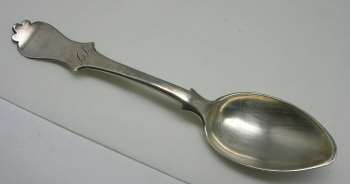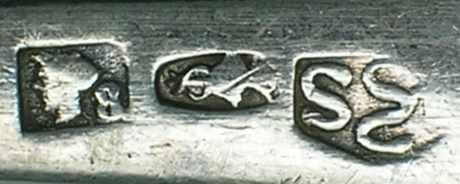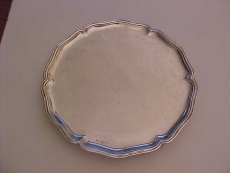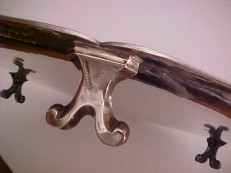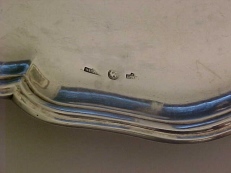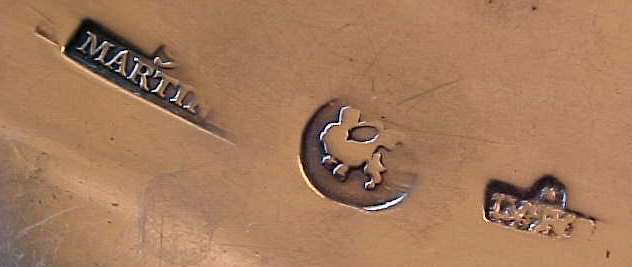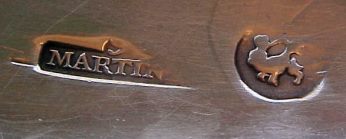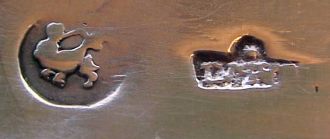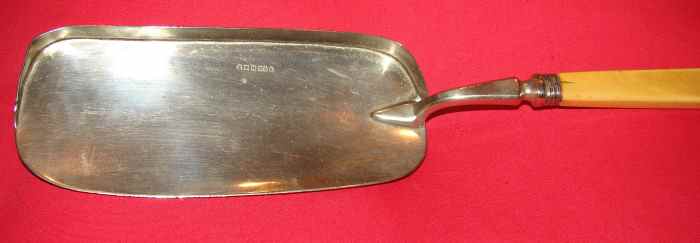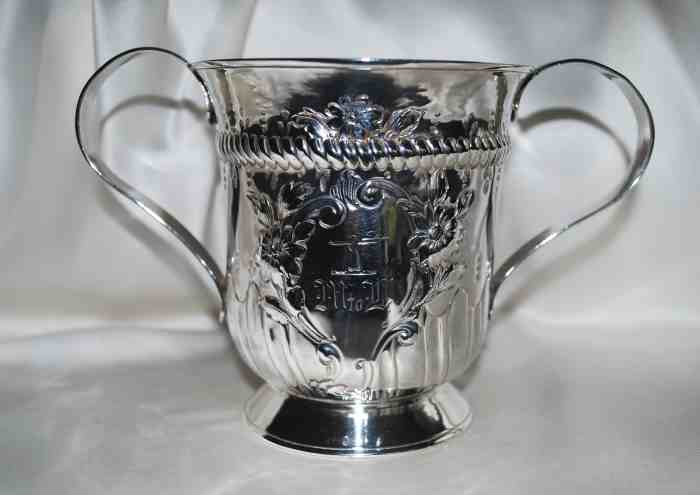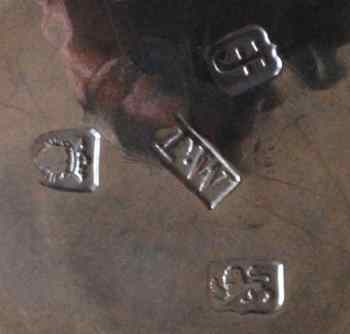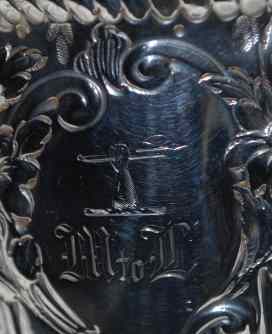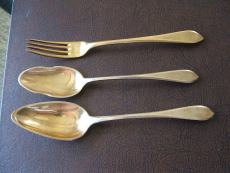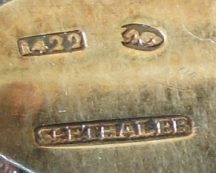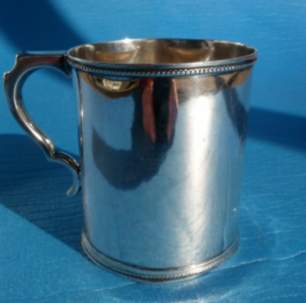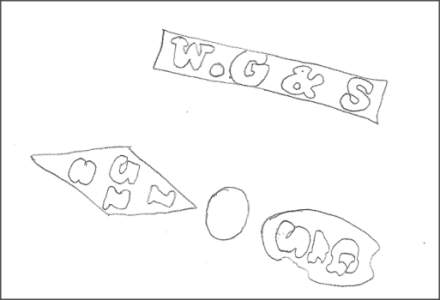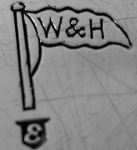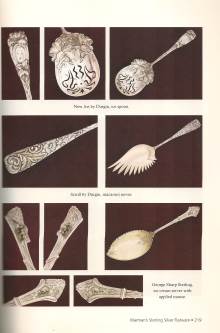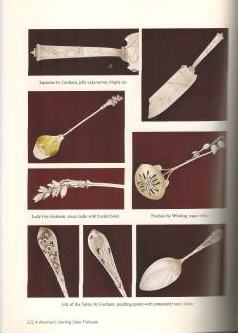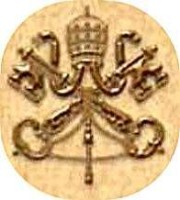
Claudio Morelli and Giorgio
Busetto present:
Papal States (Rome) Silver Hallmarks
From the French Domination (1809) to the Kingdom of
Italy (1870)

Stato Pontificio - Punzoni dell'argento
Dalla dominazione francese (1809) al Regno d'Italia
(1870)

The first statutes of the guild of Roman goldsmiths date
back to 1358, in which was stated the rule of the
warranty punch.
The University of Goldsmiths was founded in 1508 and the
statutes approved the following year introduced the use
of the master's mark in addition to the previous
guarantee mark.
In 1738, with the reform of the Statutes of Goldsmiths,
the guild acquired the name of "Nobil Collegio degli
Orefici ed Argentieri di Roma" (Noble College of
Goldsmiths and silversmiths of Rome)......
click here
 click here
click here

|
Welcome to new ASCAS members:
Rebecca Burnett Birdsal - Usa
Pat Davis - Usa
Laura Gray - Usa
Steven Morrill - Usa
Dennis K. Oakley - Usa
Francesco Sannino - Italy
Jack Smith - Usa
Steve Wexler - Usa
Massimo Simonato writes:
... I need information about the mark of this teaspoon.
Thanks for your help.
Massimo Simonato
This is a little known mark of the Kingdom of Naples used
in Sicily after 1826 (head of Ceres toward left, silver fineness
833/1000)
It is similar to the mark of Parthenope toward right used in
Naples in the same period (see my website at
http://www.silvercollection.it/NAPLESHALLMARKS.html ).
Giorgio Busetto
Francois Costes writes:
... Please find attached the photo of three marks.
They are struck on the top of an early salver that could date to
the mid-18th century.
The piece is hand hammered, except for its three feet that were
cast. Its diameter is around 16 inches (41 cm).
(a) The first mark is probably the silversmith's, apparently
MARTIN, but it could also be MARTINI. Impossible to read the
first initial in script on the top of it (maybe I, J, S, etc.).
(b) The second mark is probably the guarantee mark. Very worn,
but one could guess a standing lion struck at a 90 degree angle.
(c) The third mark is intriguing. Impossible to decipher, maybe
a city mark...
Please, help me! Thank you in advance
Francois Costes
The mark is Spanish, town of Cordoba, assayer Mateo
Martinez Moreno, year 1790/1799 (the date is partly rubbed).
I'm unable to identify the maker.
Giorgio Busetto
Dear Giorgio,
Thanks for your prompt and informative answer about the 18th
century silver salver. I had no idea that this piece was Spanish.
The first mark (MARTIN) looked to me like an American one (see
for instance Peter Martin of New York around 1750). And the
second mark (standing lion) could have been copied or created by
a colonial silversmith since America never had official assayers
- except for Baltimore during a short period (1814-1830). Iím
glad that I finally contacted you to correct these assumptions!
And here is a short descriptive that you may want to insert with
the photos in your April issue:
This salver is made of solid hammered silver except for its
three cast feet. Diameter is about 40 cm, height 5 cm. Its
hexagonal shape, scalloped edges, and simplicity are typical of
salvers made in Europe during the 18th century. It bears a coat
of arms with a ducal crown and a plummeted helmet incised in the
center. The top of the salver is also struck with three aligned
marks: The first one reads MARTIN under a centered script
initial that is half erased; The second looks like a standing
lion which is quite worn; The third mark seems impossible to
decipher. Could the ASCAS members help me confirm or identify
the period, the country, and the maker of this antique salver?
Many thanks for your feedback
Francois Costes
Dear Giorgio,
I may have found the name of the silversmith that made the
Spanish salver.
Thanks to the valuable info that you provided I was able to do
more research on the Internet.
Using the Google search engine, I decided, just an hour ago, to
target Spanish sites with key words as:
[plata] [platero] [Cordoba] ["Mateo Martinez"], and so on.
I quickly found a link between the names [Martinez] and [Luque],
with several options, one being the silversmith Juan de Luque
(y) Ramirez.
When I added this last name to my search sequence, I discovered
the following link:
dialnet.unirioja.es/descarga/articulo/107472.pdf
On this document look for the entry [8. Caliz de plata
sobredorada] (book page #149, or PDF doc page #9). The first
mark is identical to mine. The letter (L) is missing on the PDF
document, but it seems to be the same name, notably with a (Q)
that looks, on both marks, like a reversed (P), or a lowercase
(q).
Francois Costes
Chuck Keller writes:
...My wife and I purchased this in Ireland 20 years ago, at an
old castle.
While cleaning out a closet we rediscovered this wonderful piece.
I have not been able to find out what the manufacturer was.
Any help would be greatly appreciated.
Thank you,
Best regards
Chuck Keller
Maria Entrup-Henemann writes:
...some time ago I bought a porringer hallmarked for London 1781
with the maker's mark TW. I think it is the mark of Thomas Wynne,
provincial goldsmith in Bath, registered in London (Grimwade Nr.
3457). The porringer is bearing a crest (right forearm with a
halberd in its hand) over the inscription "M to L".
I send three pictures and have two questions to you and the
readers of your newsletter:
1. Am I right that the maker's mark is Thomas Wynne's and if so,
does anybody know something about his life story?
2. Does anybody know for which family this crest stands?
With many thanks and kindest regards
Maria Entrup-Henemann
I'm not sure that the maker is Thomas Wynne of Bath.
Possibly the maker is Thomas Wallis I (Grimwade 2962). According
to Grimwade he died 1818-22 and probably he was still active in
1781.
Any suggestion will be appreciated.
Giorgio Busetto
According to Tardy, your pieces are marked Augsburg (Germany)
1767/69. I have no information about the maker (Sefthaler?)
Giorgio Busetto
Thank you for the information...I've found that Seethaler
is the name of a retailer that put his name on some flatware
Bob
Andrew T. Nadell writes:
These are well known marks. The triple marks are read from
the lower right: G & S is Gale and Son. The diamond shaped or
lozenge date mark has a 1 at the 'top' then the 52 as you said,
and then the 8 at the 'bottom.' William Gale and later his son
were well known and skilled silversmiths.
Their most famous flatware pattern is known as Gothic, and was
patented in 1847, and made into the early 1850s, using the same
date lozenge. Examples of the pattern are owned by most major
American museums, including the Metropolitan Museum,
Philadelphia, Newark, Boston Museums and Winterthur.
There is a full page illustration of four pieces of the Gothic
pattern in the important book by Charles Venable, Silver in
America 1840 to 1940.
They produced a number of other flatware patterns and a great
deal of hollowware, all at a high standard of craftsmanship and
design. William Gale the father was also in partnership for some
time in the firm of Gale, Wood and Hughes. Wood and Hughes was
also a major American maker.
Andrew T. Nadell
In this column we presents a page obtained from makers'
brochures, books, auction catalogs, advertising or whatever
other printed paper, related to silver, that may be of interest
for ASCAS members.
The images will be published at a "low resolution" level and for
private and personal use only
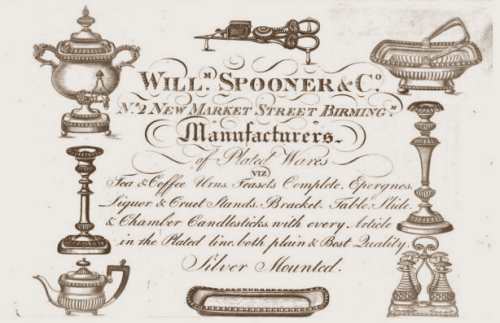
|
This month ASCAS presents an ancient advertisement
of William Spooner & Co, Birmingham
WILLm SPOONER & CO
Nį 2 New Market Street, Birmingham
Manufacturers
of Plated Wares
In 1841 William Spooner registers his mark (WS
into a rectangle) in Birmingham Assay Office
|
"A WORD per MONTH"
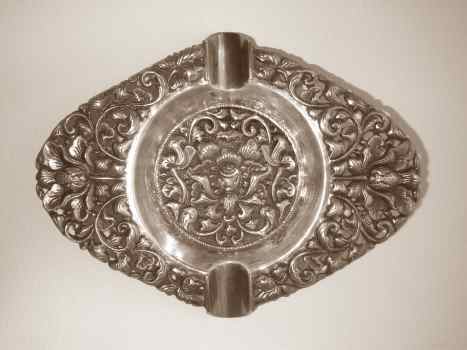
YOGYA SILVER
Silver handicraft has been practiced in Java for
many centuries.
The manufacture of silverware known as Yogya Silver
finds its origin in the second quarter of the 20th
century when a profound transformation was supported by
the conjoined efforts of Dutch and Javanese promoters of
decorative crafts.
In the 1930s Java was part of the Dutch East Indies and
the center of this production was in the provincial
capital Yogyakarta (Yogya) and in Kotagede, a small town
about five kilometers southeast.......
more
|
"A SILVERSMITH per MONTH"
|
|
DATING WALKER & HALL SILVER PLATE
From centuries British silver
is protected by the stamping of symbols and letters
identifying the maker, the Assay Office and the date in
which the quality of the silver piece was verified.
Thanks to the "date letter" any piece of British
sterling silver can be exactly dated.
Old Sheffield Plate and Electroplated silver are not
subject to this practice and the regulation issued by
the authorities had the main objective of preventing
possible frauds by unscrupulous sellers of plated ware.
The best-known initiative is the prohibition (effective
from c. 1896: Elkington was forced to change its mark in
1898) of stamping plated wares with the "crown", to
avoid misunderstanding with the symbol identifying the
Sheffield Assay Office.
The absence of an official dating system makes it
difficult to date silver plated wares. An approximate
date can be determined by examining:
- the style of the object
- the presence or absence of the crown (before or after
c. 1896)
- the date of registration of the pattern at the Patent
Office
- the presence of a dated dedication
- the date of the event (example: King/Queen Coronation
or Jubilee commemorative spoons)......
more
|
"A BOOK ON MY SHELF"
In this column we present books, new
or ancient, dealing with silver in all its aspects (history,
marks, oddities...). This isn't a "book review" but only a fair
presentation of some useful "tools" that anyone may have in the
shelf of his bookcase.
ASCAS members are invited to contribute to this column
(click to enlarge images)
In the "book on my shelf" of this month ASCAS presents:
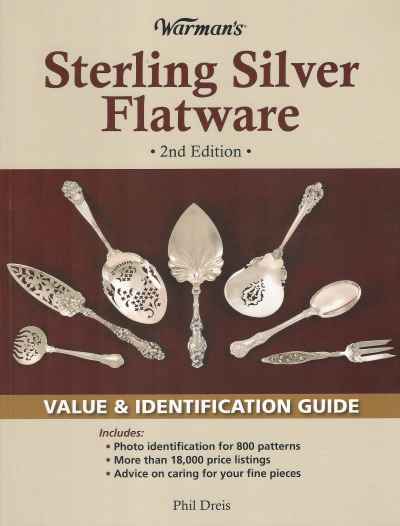
|
STERLING SILVER FLATWARE
Value & Identification Guide
by Phil Dreis
Krause Publications Inc
2009
This second edition offers more than 1,400 photos
and illustrations, with up-to-date pricing for 15,000
pieces.
A 16-page color section highlights some of the rare and
highly prized pieces made during the last two centuries.
Dozens of American makers are profiled, along with
select European silversmiths.
Author Phil Dreis discusses the state of the silver
market, new trends in silver sales, and the effects of
the Internet on the business.
With a comprehensive bibliography, answers to frequently
asked questions, glossary, production terms, and
information on repairs and cleaning, this book is a
must-have resource for collectors and dealers alike.
|
Closing our APRIL 2013 edition of
ASCAS Newsletter I hope you have appreciated its content.
Your comments, suggestions and advice will be of great help.
My thanks to Bob Charter, Francois Costes, Maria Entrup-Henemann,
Chuck Keller, Claudio Morelli, Andrew T. Nadell and Massimo
Simonato, for their precious contributions.
Giorgio Busetto
Secretary
DISCLAIMER AND PRIVACY POLICY
ASCAS is a community of people having a common
interest in antique silver.
It is a non-profit association without commercial links.
Membership is open to whomever has a true interest in
this subject matter.
ASCAS has no real property and no fees are requested nor
accepted from members.
ASCAS keeps in touch with its members only through
periodical newsletters, e-mails and web-site updating
and ignores and is not responsible for any other
activity pursued by its members.
Likewise, ASCAS is not responsible for opinions,
evaluation and images displayed, and in any form
published or supplied for publication, by its members
who, in any case, maintain the property of their works
and assure the respect of national and international
legislation about Intellectual Property.
ASCAS does not have the full addresses of its members (only
town, country and e-mail address are requested for
membership).
ASCAS handles and protects with care its members' e-mail
addresses, will not disclose the addresses to third
parties, will use this information only to reply to
requests received from members and for communications
strictly related to its activity.
These rules are expressly accepted by submitting the
membership request.
|
|
 newsletter
# 107 April 2013
newsletter
# 107 April 2013






